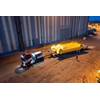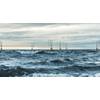Offshore Wind Spend to Average $21B per year
Douglas-Westwood (DW) forecast offshore wind installations averaging 3.2 GW per year over the next ten years with capital expenditure hitting a peak of $24.1B in 2016. The fifth edition of DW’s World Offshore Wind Market Forecast launched today presents a new longer-term forecast and examines the key commercial developments since the last publication to provide detailed insight to established players and new entrant alike.
“For many countries, including the UK and Germany, offshore wind is a key component in the future electricity generation mix,” commented report author Dmitry Dovgan, “to date, the UK market has been the main driver of growth, with many important lessons learned along the way. At the current time, we see increasing activity in Germany with a large amount of new capacity set to come online in the near future.”
The DW approach to market modeling takes a conservative view, with particular sensitivity to the more speculative projects. “Historically, growth has been slower than expected, and many uncertainties are yet to be resolved. However, there is a positive upward trend, with significant expenditure expected, which has attracted many of the largest industrial players from Areva to Samsung Heavy Industries,” commented DW manager Frank Wright.
The report highlights a series of challenges which are acting to constrain development, including the high cost levels in the industry. Capital outlays and recurring operational spending mean that subsidies are required to support development, at a time when the public finances in key markets such as the UK and Germany are squeezed and the consumer is seeing an upward trend in energy prices. This makes it increasingly difficult for governments to justify support, leading to a focus on identifying cost reduction strategies including standardisation of business practices and development of larger wind turbines designed specifically for the offshore environment.
From a financing perspective the risks associated with offshore construction, new wind turbine technology and offshore operations have made it difficult for project developers to tap into new sources of capital. The current dependence on global utilities to self-fund projects is unsustainable in the long-run, leading to a potential funding gap in the future. As larger players continue to enter the market, often from the offshore oil & gas sector, and new wind turbines reliability is proven over a sustained period of time, it is hoped that new investors will become more comfortable with the risk profile.
















 February 2024
February 2024



